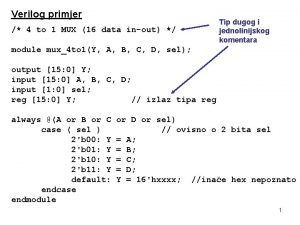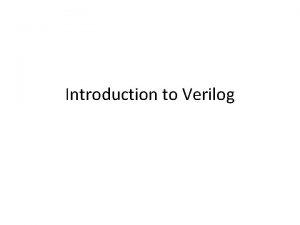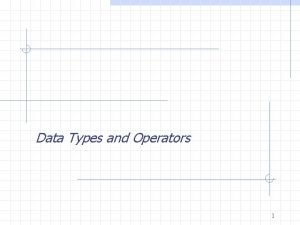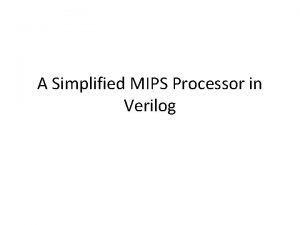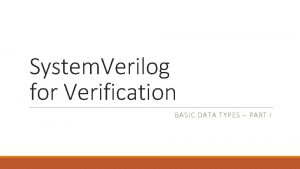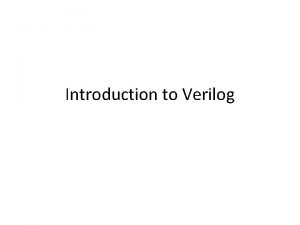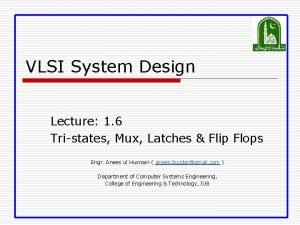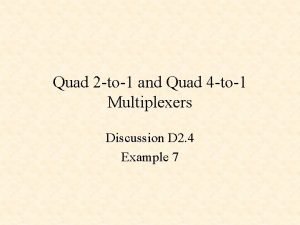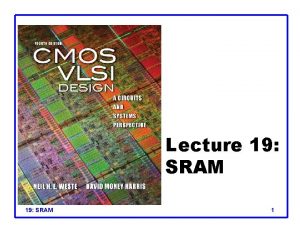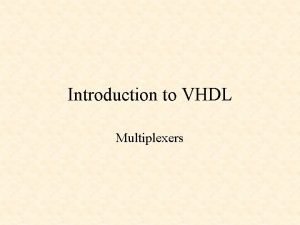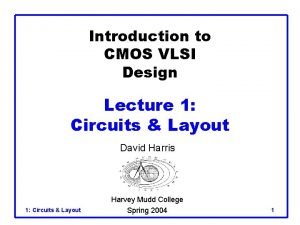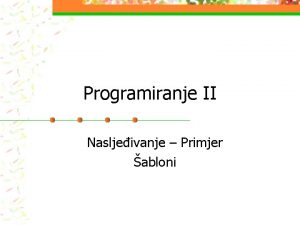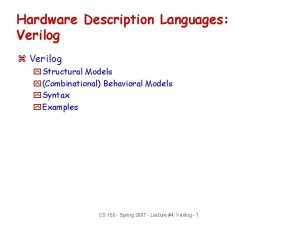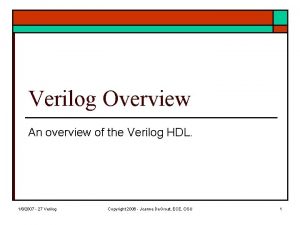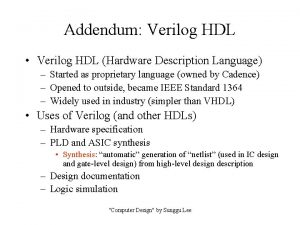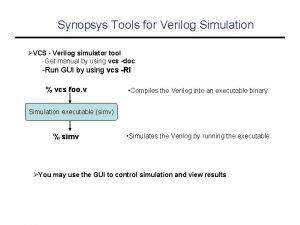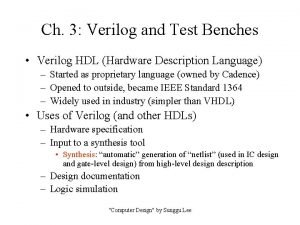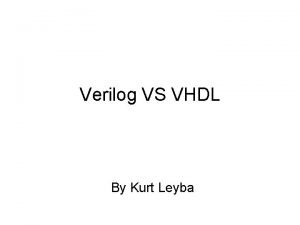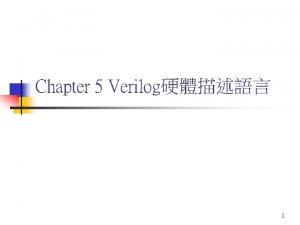Verilog primjer 4 to 1 MUX 16 data





![Verilog primjer // 4 -bit Adder module Adder(A, B, Result); input [3: 0] A; Verilog primjer // 4 -bit Adder module Adder(A, B, Result); input [3: 0] A;](https://slidetodoc.com/presentation_image/277b9c9c8a5c953351be5bb64e119366/image-6.jpg)








![// combination portion always @(in or current. State) begin out = ~current. State[1] & // combination portion always @(in or current. State) begin out = ~current. State[1] &](https://slidetodoc.com/presentation_image/277b9c9c8a5c953351be5bb64e119366/image-15.jpg)
- Slides: 15

Verilog primjer /* 4 to 1 MUX (16 data in-out) */ Tip dugog i jednolinijskog komentara module mux_4 to 1(Y, A, B, C, D, sel); output [15: 0] Y; input [15: 0] A, B, C, D; input [1: 0] sel; reg [15: 0] Y; // izlaz tipa reg always @(A or B or C or D or sel) case ( sel ) // ovisno o 2 bita sel 2'b 00: Y = A; 2'b 01: Y = B; 2'b 10: Y = C; 2'b 11: Y = D; default: Y = 16'hxxxx; //inače hex nepoznato endcase endmodule 1

Verilog primjer // 1 -bit Register module Reg 1(clk, I, enb, Q); input clk; input I, enb; output Q; reg Q; always @ (posedge clk) begin if( enb == 1 ) Q <= I; endmodule nonblocking assign (isti vremenski trenutak za cijeli oblikovani sustav) 2

Verilog primjer /* 32 bit register with an asynchronous reset (active low) */ module Reg 32(Q, D, clk, reset_); output [31: 0] Q; input [31: 0] D; input clk, reset_; reg [31: 0] Q; // izlaz tipa reg always @(posedge clk or negedge reset) if (!reset_) // ako reset (neg) stavi 0 Q <= 32'b 0; // non blocking assign else Q <= D; // inače stavi što je na ulazu endmodule ! logical NOT 3

Verilog primjer // 2 x 4 Decoder // Truth table for 2 x 4 Decoder // A B | D 3 D 2 D 1 D 0 //-----+--------// 0 0 | 0 0 0 1 // 0 1 | 0 0 1 0 // 1 0 | 0 1 0 0 // 1 1 | 1 0 0 0 module Decoder(A, B, D); input A, B; output [3: 0] D; reg [3: 0] D; // nastavak na slijedećoj slici 4

Verilog primjer // nastavak 2 x 4 Dekoder always @ (A or B) begin if( A == 0 && B == 0 ) D <= 4'b 0001; // non blocking assign else if ( A == 0 && B == 1 ) D <= 4'b 0010; else if ( A == 1 && B == 0 ) D <= 4'b 0100; else D <= 4'b 1000; endmodule 5
![Verilog primjer 4 bit Adder module AdderA B Result input 3 0 A Verilog primjer // 4 -bit Adder module Adder(A, B, Result); input [3: 0] A;](https://slidetodoc.com/presentation_image/277b9c9c8a5c953351be5bb64e119366/image-6.jpg)
Verilog primjer // 4 -bit Adder module Adder(A, B, Result); input [3: 0] A; input [3: 0] B; output [3: 0] Result; reg [3: 0] Result; always @ (A or B) begin Result <= A + B; endmodule ******************** Napomena: • “Register” operandi su “unsigned” • Ako je jedan operand nepoznat (“x”), rezultat je nepoznat (“x”) • “Carry” se ignorira u ovom primjeru 6

Verilog primjer // Adder, uporaba “parameter” i “assign” naredbe module adder (sum, a, b); parameter WIDTH = 7; // ovdje 8 bita, može se mijenjati input [WIDTH: 0] a, b; output [WIDTH: 0] sum; assign sum = a + b; endmodule ************************ Napomena: • Naredbom “assign” će se promijeniti “sum” ako se promijene “a” ili “b” BILO KADA (a ne kao što to u drugim prikazanim slučajevima određuje “blocking” i “nonblocking” pridruživanje). Ovdje korištena naredba “assign” prikazuje doslovnu karakteristiku kombinacijske logike (kao da su elementi čvrsto i stalno povezani žicama). 7

Verilog primjer // jednobitno zbrajalo, 3 bita na ulazu module one. Bit. Full. Adder(c. Out, sum, a. In, b. In, c. In); output c. Out, sum; input a. In, b. In, c. In; assign sum = a. In ^ b. In ^ c. In, c. Out = (a. In & b. In) | (b. In & c. In) | (a. In & c. In); endmodule // operator “^“ je “bitwise XOR” // operator “|” je “bitwise” OR // operator “&” je bitwise AND // operator “~” je bitwise komplement ******************** Napomena: Naredba “assign” je niže razine apstrakcije nego “blocking” i “nonblocking” pridruživanje. Bliže je opisu izvedbe digitalnih sustava logičkim sklopovima. 8

Verilog primjer /* 4 -bit Multiplier, consists of 2 4 -bit inputs A and B, and an 8 -bit output */ module Multiplier(A, B, Result); input [3: 0] A; input [3: 0] B; output [7: 0] Result; reg [7: 0] Result; always @ (A or B) begin Result <= A * B; endmodule 9

Bin inputs: A B C D Verilog primjer A=23, B=22, C=21, D=20 Output: e LED only e AB CD for HEX character Ex. 1 1 0 1 = 13 DEC = HEX char. “d” e LED = 1 (ON) 10

Verilog primjer - FSM Kombinacijska logika xi QNEXT = f(x, Q) Mealy: z = g(Q, x) Qi Moore z = h(Q) clock in/out (in 1 bit, out 3 bita) 1/100 A 1/100 B jedan “module” Trenutno stanje (sekvencijski dio – bistabili) reset 0/000 1/101 C dvije “always” naredbe (kombinacijska i sekvencijska) zajedno definiraju rad FSM-a 0/010 1/110 D 0/000 reset zi E 0/010 0/000 ? /101 1/110 F 11

Verilog primjer - FSM module fsm (i, clock, reset, out); input i, clock, reset; output [2: 0] out; // output 3 bita reg [2: 0] out; reg [2: 0] current. State, next. State; //3 bita OK parameter [2: 0] A = 0, // state assignments B = 1, // for current/next C = 2, D = 3, E = 4, ako se promijeni F = 5; //1 st always: comb logic, out and next. State functions always @(i or current. State) If true then, else case (current. State) A: begin next. State = (i == 0) ? A : B; out = (i == 0) ? 3'b 000 : 3'b 100; 12 end

Verilog primjer - FSM B: // analogno za B, C, D, E C: D: E: F: begin next. State = D; out = (i == 0) ? 3'b 101 : 3'b 101; end default: begin // if undeined states, go to A next. State = A; out = (i == 0) ? 3'bxxx : 3'bxxx; end //out = don’t care endcase nonblocking = acress the whole design // sequential part always @(posedge clock or negedge reset) if (~reset) // reset = low current. State <= A; else // posedge clock current. State <= next. State; 13 endmodule

Verilog primjer – FSM (malo pos. edge 0 neg. edge reset drugačije označavanje) If in state 1 out is generated. 1 00/0 0 1 01/1 clock 1 11/0 Moore FSM: out is a function of state only 0 State Input module fsm(out, in, clock, reset); output out; input in, clock, reset; reg out; reg [1: 0] current. State, next. State; // combination portion // * * * // sequential portion // * * * endmodule 14
![combination portion always in or current State begin out current State1 // combination portion always @(in or current. State) begin out = ~current. State[1] &](https://slidetodoc.com/presentation_image/277b9c9c8a5c953351be5bb64e119366/image-15.jpg)
// combination portion always @(in or current. State) begin out = ~current. State[1] & current. State[0]; Bit select = 01 // out = 1 only for state 01 next. State = 0; if (current. State == 0) if(in) next. State = 1; //else stay in 0 if (current. State == 1) if (in) next. State = 3; //else go to 0 if (current. State == 3)begin if (in) next. State = 3; else next. State = 1; end // the sequential portion always @(posedge clock or negedge reset) begin if (~reset) current. State <= 0; // as long as res=0 else current. State <= next. State; // as D type bistable end non blocking 15
